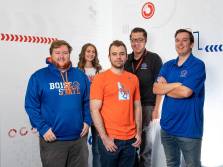U. Maine Augusta opens cyber range for hands-on student training

Hands-on experience is a critical component of cybersecurity education, and cyber ranges, like the one the University of Maine at Augusta opened last month, give students valuable experience a cybersecurity professor told EdScoop.
The pipeline of cybersecurity talent has been unable to keep pace with the dramatic rise in cybercrime, leaving many IT security teams shorthanded. As of January 2019, the United States has struggled to fill almost 314,000 cybersecurity jobs, according to one analysis.
“I want my students, when they graduate, to go and fill those jobs and to do very well at them,” said Henry Felch, a professor of computer information systems at the University of Maine at Augusta. He added that hands-on practice is one of the best ways for students to strengthen their skill sets and get a competitive edge for when they enter the workforce.
One way that the University of Maine at Augusta is tackling this issue and starting to educate students on the application of cybersecurity is through cyber ranges. Cyber ranges not only give students the opportunity to experience and learn from realistic cyberattack simulations but also help support the broader community through workforce development and professional training.
“In a lot of lab environments you find today that involve virtual systems, the system is always the same,” Felch said. “Here, [the cyber range] simulates what you would actually be doing in real life.”
UMA’s range, developed by cybersecurity training company Cyberbit, has about 14 simulations that students can work through, Felch said.
“Students sit in an environment simulating an operations center and they’re monitoring devices and looking for any compromises,” he said. “The whole concept is to identify a possible attack, prevent the attack … and recover anything from it.”
The scenarios are able to be further adjusted by the trainer, Felch said, by changing how long the simulation plays out before the attack begins and the amount of network traffic to obscure malicious activity.
“This is the closest thing to the real thing that they will ever have,” he said. “[But] this isn’t only about students. It’s also about workforce development.”
In the case of small businesses and local government IT, there is often only one person or a very small team in charge of all aspects of developing and maintaining IT systems — including security. For this reason, Felch said he hopes that UMA’s cyber range will be used by the community and provide meaningful opportunities for students, local businesses and government agencies to strengthen their cybersecurity knowledge.
The range shows people what an attack looks like, how it occurs, how to detect it and respond to it, Felch said.
“I can tell you and teach you how to configure a firewall, how to manage a firewall, how to look in logs,” he said, “but until you actually do it, you never really learn.”




